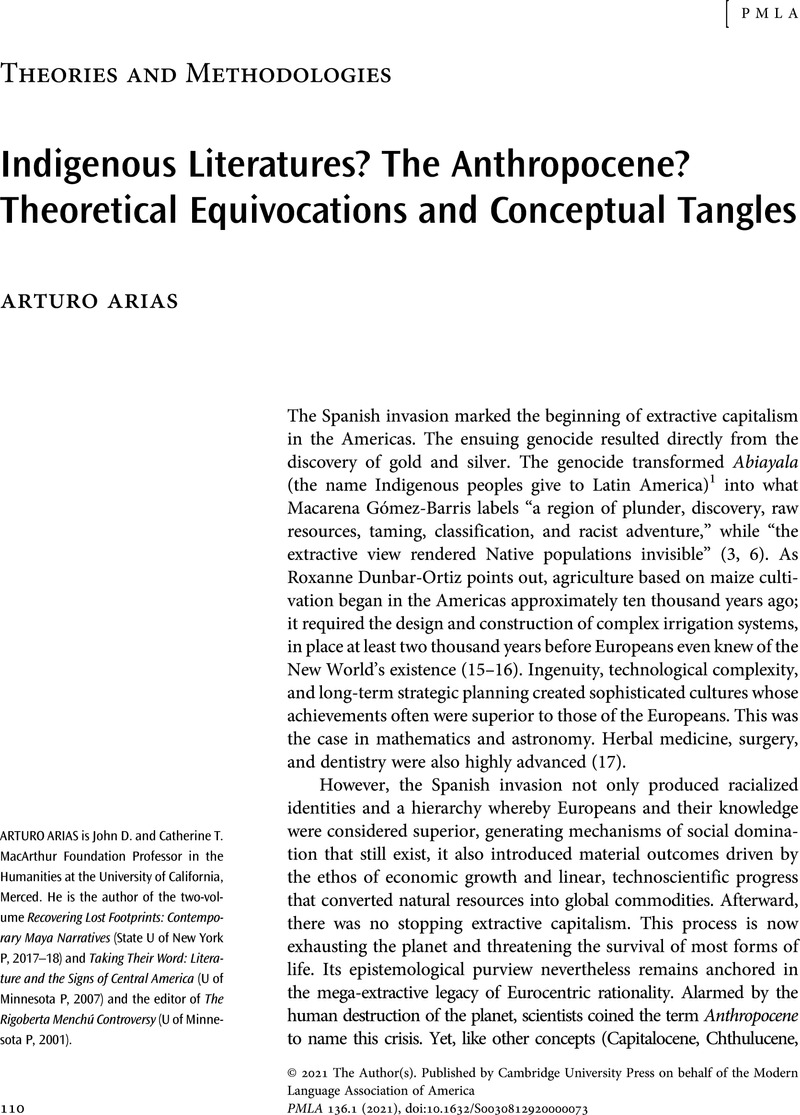No CrossRef data available.
Article contents
Indigenous Literatures? The Anthropocene? Theoretical Equivocations and Conceptual Tangles
Published online by Cambridge University Press: 27 January 2021
Abstract
An abstract is not available for this content so a preview has been provided. Please use the Get access link above for information on how to access this content.

- Type
- Theories and Methodologies
- Information
- Copyright
- Copyright © 2021 The Author(s). Published by Cambridge University Press on behalf of the Modern Language Association of America
References
Works Cited
Abrams, David. The Spell of the Sensuous: Perception and Language in a More-than-Human World. Vintage Books, 1997.Google Scholar
Acuña-Soto, Rodolfo, et al. “When Half of the Population Died: The Epidemic of Hemorrhagic Fevers of 1576 in Mexico.” FEMS Microbiology Letters, vol. 240, 2004, pp. 1–5.CrossRefGoogle ScholarPubMed
Arias, Arturo. Recovering Lost Footprints: Contemporary Maya Narratives. 2 vols. State U of New York P, 2017–18.Google Scholar
de la Cadena, Marisol. Earth Beings: Ecologies of Practice across Andean Worlds. Duke UP, 2015.Google Scholar
de Lión, Luis. Time Commences in Xibalbá. Translated by Henne, Nathan C., U of Arizona P, 2012.Google Scholar
Dunbar-Ortiz, Roxanne. An Indigenous Peoples’ History of the United States. Beacon Press, 2014.Google Scholar
Gómez-Barris, Macarena. The Extractive Zone: Social Ecologies and Decolonial Perspectives. Duke UP, 2017.CrossRefGoogle Scholar
Grim, John. “Knowing and Being Known by Animals: Indigenous Perspectives on Personhood.” A Communion of Subjects: Animals in Religion, Science, and Ethics, edited by Waldau, Paul and Patton, Kimberly, Columbia UP, 2006, pp. 373–90.Google Scholar
Gutiérrez Mendoza, Gerardo. “Four Thousand Years of Graphic Communication in the Mixteca-Tlapaneca-Nahua Region.” Mixtec Writing and Society: Escritura de Ñuu Dzaui, edited by Jansen, Maarten E. R. G. N. and van Broekhoven, Laura N. K., KNAW Press, 2008, pp. 71–107.Google Scholar
Lovell, W. George, et al. “Strange Lands and Different Peoples”: Spaniards and Indians in Colonial Guatemala. U of Oklahoma P, 2013.Google Scholar
Medrano, Manuel, and Urton, Gary. “Toward the Decipherment of a Set of Mid-Colonial Khipus from the Santa Valley, Coastal Peru.” Ethnohistory, vol. 65, no. 1, Jan. 2018, pp. 1–23.CrossRefGoogle Scholar
Nielsen, Jesper, and Helmke, Christophe. “House of the Serpent Mat, House of Fire: The Names of Buildings in Teotihuacan Writing.” Mesoamerican Writing Systems, Polish Academy of Arts and Sciences / Jagiellonian University / Institute of Archaeology, 2014, pp. 113–40. Vol. 7 of Contributions in New World Archaeology.Google Scholar
Schulz, Karsten A. “Decolonizing Political Ecology: Ontology, Technology and ‘Critical’ Enchantment.” Journal of Political Ecology, vol. 24, 2017, pp. 125–43.CrossRefGoogle Scholar
Šprajc, Ivan. Venus, Lluvia y maíz: Simbolismo y astronomía en la cosmovisión mesoamericana. Instituto Nacional de Antropología e Historia, 1996.Google Scholar
Steffen, Andrea D. “A Better Way to Extract Rare-Earth Elements for Green Tech Has Been Discovered.” Intelligent Living, 28 Apr. 2019, www.intelligentliving.co/better-extract-rare-elements/.Google Scholar


